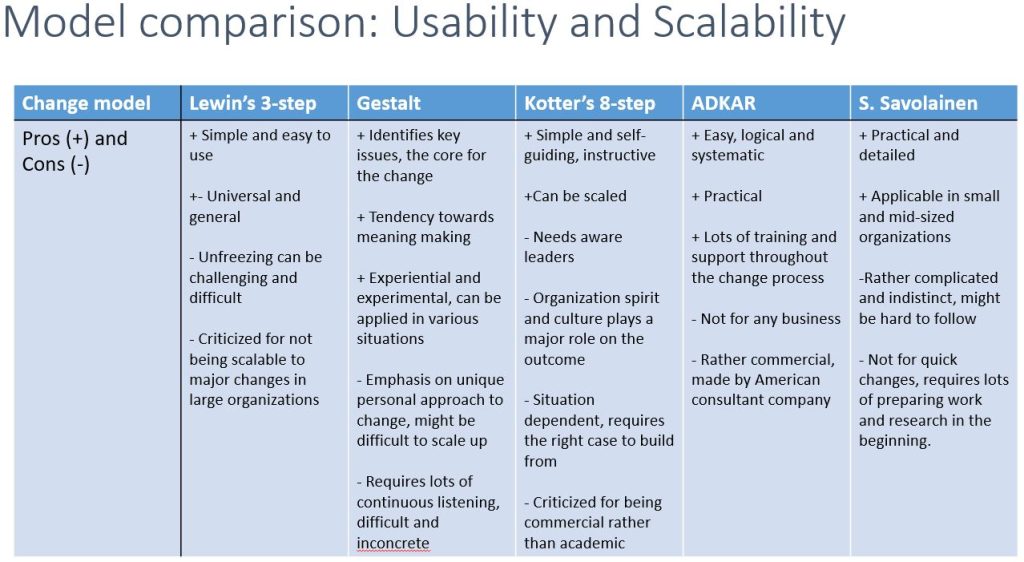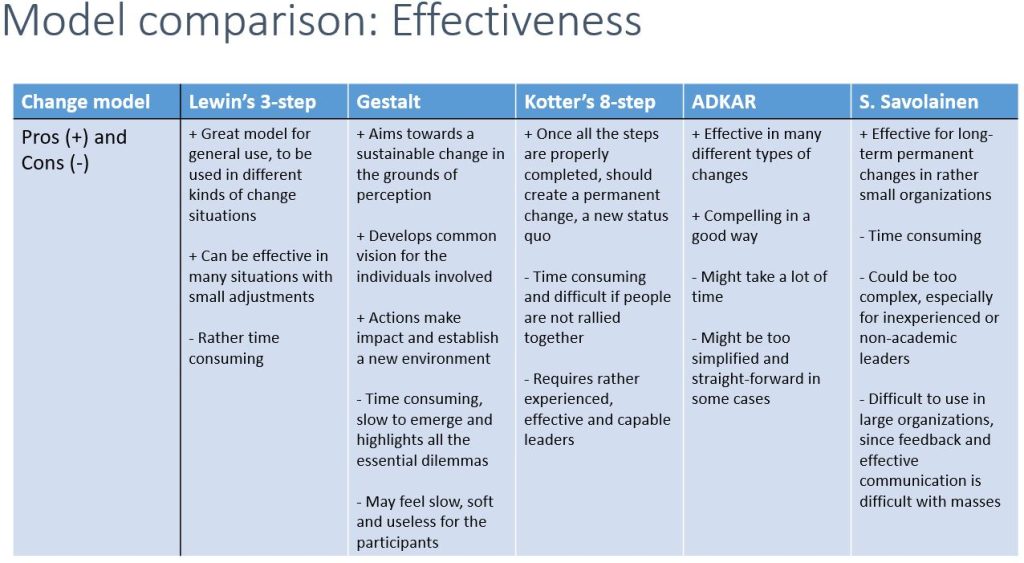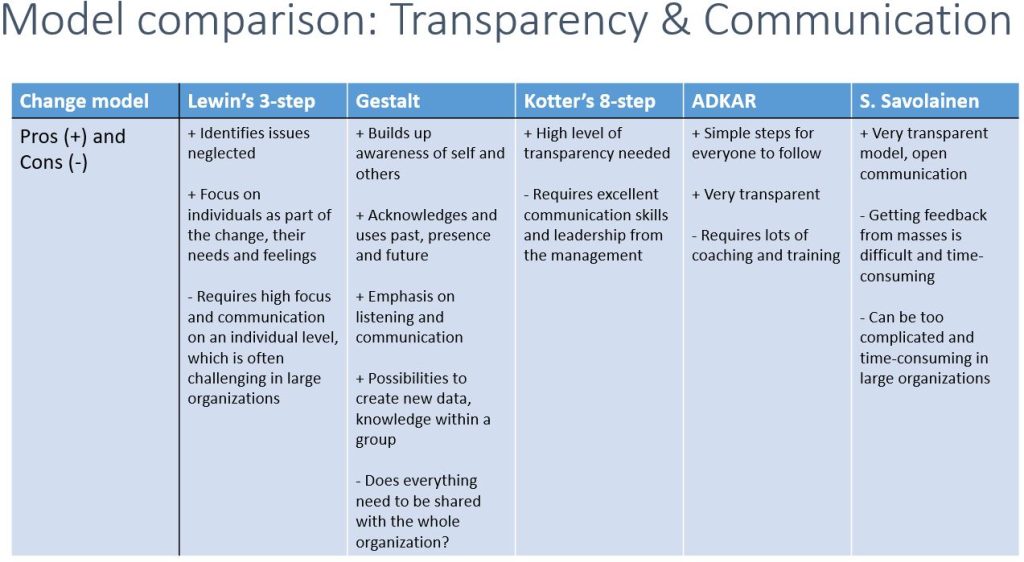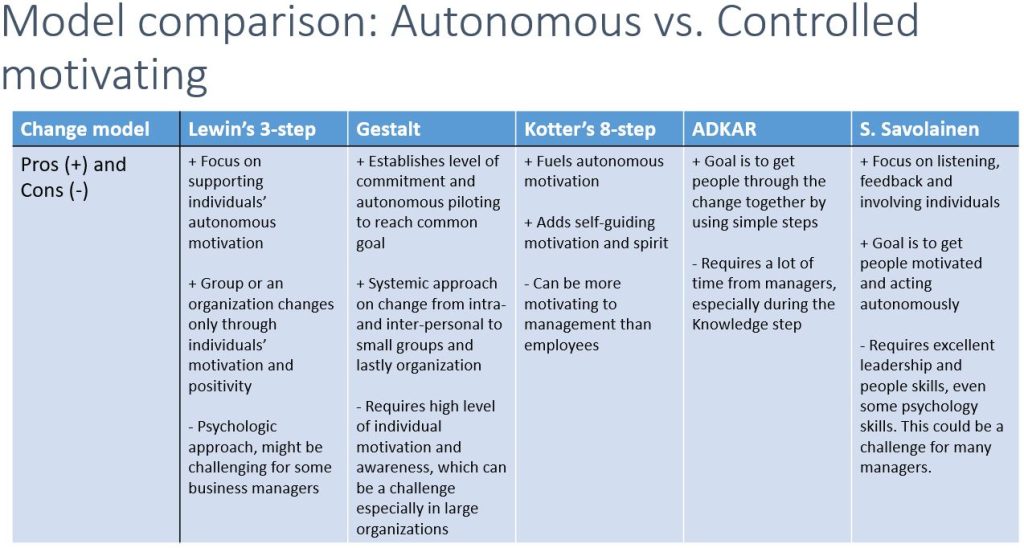
Comparison of change management models and suggestions for top management based on them
Introduction
This article is based on author´s MBA Thesis ”Evaluation of change management of the implementation of a new ERP system in a certain department of a large international company”, published in Turku University of Applied Sciences in 2023. The thesis was a case study, investigating the change process of new ERP system implementation in a large international technology company. The change was studied and evaluated from employees’ point of view, intention in finding out the case company’s main challenges in change management.
Thesis’ theory part introduced five different change management models, most of them being commonly known in the field of change management. The five different models presented are: Kurt Lewin’s 3-step model of change, Gestalt approach, Kotter’s 8-step model, ADKAR model, and Constructive change execution model by Sari Savolainen. Lewin’s model, Kotter’s 8-step model and the ADKAR model are commonly known and globally widely used. Gestalt approach is often seen as challenging to understand and use in practice. Sari Savolainen published her model at Jyväskylä University in her Doctoral Dissertation in Finland in 2015.
This article presents comparison of the different change management models, including pros and cons of different models. Model comparison is done from four different perspectives: 1. Usability and scalability, 2. Effectiveness, 3. Transparency and communication, 4. Autonomous versus controlled motivating. The article concludes with comparison summary and presents suggestions for companies evaluating their change management strategies and models.
Comparison
The five change management models are here shortly presented, followed by model comparison tables. This article does not cover the details of the different models, but more detailed theoretical information can be gained from authors MBA-Thesis and the reference sources presented.
Kurt Lewin (1890 – 1947) was one of the prominent figures in the field of social psychology and is often recognized as “the founder of social psychology” or “the father of social change theories” (Haggbloom et al. 2002; Huarn et al. 2016). The focus of his theories and models is on individual and group behavior; the importance of changing individuals to make an organizational change happen. His 3-step model, often cited as Lewin’s key contribution to organizational change, consists of three steps: 1. Unfreezing, 2. Changing, 3. Refreezing (Burnes 2004; Lewin 1947).
Gestalt psychology is a school of psychology that emerged in the early 20th century among a group of German-Austrian psychologists. Gestalt psychologists emphasize that organisms perceive entire patterns or configurations, rather than merely individual components. The Gestalt approach offers a way on looking for and respecting what already exists. Starting by asking, how does the system function and what is well-developed, only then looking for what is missing or what is underdeveloped. Gestalt puts emphasis on contacts with people, context, history and need. In Gestalt approach the cycle of experiences and change process consists of: Framing, Showing, Listening, Practice, Change, Closure (Farrands 2012; Gillie 2011; Nevis 1987).
John P. Kotter is internationally regarded as the authority on leadership and change. Kotter originally introduced his eight-step change model in his 1995 book “Leading Change”. The model consists of 8-steps proceeding in sequence to accomplish a successful change. Kotter’s 8-step change process begins with creating urgency and finishes up with making the change stick (Kotter 2008; Kotter 2012).
The ADKAR model is a goal-oriented change management model that guides individual and organizational change, originally created by Prosci founder Jeff Hiatt in 2003. ADKAR is an acronym that represents the five tangible and concrete outcomes that individuals need to achieve for change to be successfully realized: Awareness, Desire, Knowledge, Ability and Reinforcement. These goals or outcomes are sequential and cumulative, meaning they must be achieved in order. The ADKAR model underlines that changes have two dimensions: the business / project side of change and the people side of change (Prosci 2020).
On her Jyväskylä University Doctoral Thesis “Cognitive appraisal theory and psychological acceptance during organizational change”, Sari Savolainen (2015) presents a Constructive change execution model. According to her thesis, in an organizational change situation, the main challenge is on managing people’s unique and individual behavior and their psychological processes. On this basis, change management should focus on how to guide individuals’ actions and behavior away from Destructive, to the direction of Constructive. To make organization’s constructive change possible, Savolainen presents Constructive change execution model, consisting of 7 steps change process (Savolainen 2015).
The model comparison with pros and cons is presented in the following four tables, each table having their own perspective for comparison: 1. Usability and scalability, 2. Effectiveness, 3. Transparency and communication, 4. Autonomous versus controlled motivating. Change models and approaches presented have slightly different influence levels, from creating an urgency, like in Kotter’s model, to focusing on the change from within. The models have different emphasis for example in motivation, communication, scalabity and level of psychology. Each model has their pros and cons. Therefore, change management in practice requires certain knowledge of the theories, for change managers being able to choose the correct approaches for their change initiatives.
It is obvious that all the models seek to make a change that lasts. This requires a high level of transparency. The models differ a bit on the level of transparency, depending on the management approaches, such as Top-down vs. Bottom-up, or change from the environment vs. change from within. For example in Kurt Lewin’s 3-step model of change, an efficient change manager is needed to move the organization towards accomplishing the target goals in each step. In all the change steps, manager and the employees managed should work together in a team to drive from one point to another until reaching another static point again. Such teamwork requires high level of transparency and open sharing of information. The ADKAR change model is a great tool not only for change management, but also for individuals that are going through a change by themselves. It helps people to stay on track during the different steps of change. Sari Savolainen’s Constructive Change Model has a very humanistic approach on change management, as the model is based mainly on psychology; individual’s cognitive processes and feelings. Also, Gestalt Approach acts on change from individual perception, having a high focus on social psychology. Gestalt Approach is often seen as very theoretical and difficult for most to understand. It might be challenging to use in practice, even for change management professionals. Whereas Kotter’s 8-step model offers a fighting chance to change company’s ways of working, emphasizing business management. It’s self-guiding and clear path with important steps which are easy to describe for people participating. The power of Kotter’s model resides in people and the more rallied persons are involved, the faster and more effective the change movement is.
In terms of usability and scalability, in large organizations it’s often difficult and time consuming to do the background research and planning, communicating effectively, getting feedback and sensing the atmosphere. Thus, using Savolainen’s Constructive Change Model or Gestalt approach could be challenging in large organizations if a major, fast pacing change is needed. Gestalt approach is highly consultative method to pursue change. ADKAR could be a usable model for changing and fixing dysfunctional processes in organizations operations. The organization should check all the five ADKAR elements, and if some of these are missing or is not complete, they could start by filling in the missing parts. ADKAR approach is clear and simple for everyone to use, also on a personal level outside working life. Kurt Lewin’s model makes emphasis on building a trustworthy teamwork. Kotter’s 8-step model is excellent for business, marketing and sales related operations. All the models are somewhat scalable to different organizations, situations and changes. Though it is clear that for example focusing on each individual’s thoughts is impossible in the case of large organization with a major change initiative. Some models react more from the inside, whereas others focus more on influences from the outside.
It’s worth noting that the more grounded and individual-based the change theory is, the more time consuming it is for the management. Gestalt approach, Kurt Lewin’s and Sari Savolainen’s models require collecting data, sensing organizations atmosphere, and general understanding of social psychology. Such theories could be challenging for managers not interested or not familiar with the psychological aspects of management. ADKAR and Kotter’s models are more straightforward, easier for everyone to understand and less time-consuming. In terms of autonomous versus controlled motivating, all models seek to positively affect the automotive motivation. Motivated people are willing to work for the change, they are willing to do the needed actions for desired changes to happen – changes either in themselves or in the environment. Gestalt approach and Lewin’s 3-step model put a high focus on individuals and their psychology, changing people from the inside. Whereas ADKAR and Kotter’s model lean on motivation through excellent management and leadership, motivating groups rather than focusing too detailed on individuals. Savolainen’s model lands somewhere between, as it focuses on listening and involving individuals. On the other hand, it requires excellent management and leadership skills, also some experience in the field of psychology. In the end, all the models seek to get individuals and groups autonomously motivated, moving towards the common goals for change. Some just focus more on organizational change management and leadership, others put more value and trust on individuals, their mind and self-awareness.




Conclusions and suggestions
All the five presented change management models have something in common, but each has their own kind of approaches and framing. Some models have a broader and more general view, by purpose leaving case dependent details open for the change manager to adapt and adjust, depending on the needs of a certain change case. Others, such as Kotter and ADKAR, have rather ready-made clear steps to be used in organizations large or small, public or private. Some of the models focus more on individuals and psychology, while others are business and management oriented, rather straightforward models. It’s obvious that choosing the proper change management theories and models might be challenging. Good change managers often apply several different theories and approaches for managing the change process, specific strategies depending on the features of a certain change initiative.
Even though change management is broadly studied among management researchers and practitioners, there is no consensus on how change situations should be led. The fragmentation of change management theories leaves the manager able to use a wide range of different methods. This in turn can make it challenging to utilize consistent practices and assessments in managing change. All in all, good change managers must have good competences on visioning, organizing, motivating and communicating. Also, a good leader is trustworthy and reliable. People follow a person they can rely on. Trustworthiness in emphasized especially in change situations, as some level of uncertainty is always present in changes.
Kurt Lewin, Gestalt approach and Sari Savolainen’s model are more theoretical and psychology oriented, at least some of them being more difficult to practice concretely in business management. Especially the Gestalt approach might be difficult to use in practice, as it’s seen difficult to understand even for the change management professionals. Though all the theories help business managers in understanding the basic principles of change management and the aspect of social psychology involved in organizational changes. For example Kurt Lewin’s “Unfreeze, Change, Refreeze” is often seen as the very basis of change management as most of the later developed theories and models lay their ground on Lewin’s basic principles. Nevertheless, more commercial models like Kotter’s 8-step model or the ADKAR model might often be easier for managers to understand, adapt and practice. Savolainen’s constructive change execution model is democratic, bottom-up approach where employees are involved in decision-making and they are given more responsibility. Though most major companies and organizations, also in Finland, are used to top-down management, where change management and decision-making is done by top-management. Employee involving, more participatory bottom-up models might work better in minimizing change resistance, as the employees accept changes better when taken along and given more responsibility in initial change planning.
In addition to the models presented, large organization’s top-management should always lead their change management through a change portfolio. Rhythm and magnitude of different changes has an effect on organization’s performance, as changes always require resources and time. Herold et al. (2008) point out that too many changes over a short period of time significantly reduces organization’s performance. The organization requires enough time for recovery, time for adapting and making a certain change happen. Too many changes done too frequently has a negative impact on performance over time. Thus, large organization’s should have a change portfolio with a responsible portfolio manager, so that different change projects around the organization are led and controlled in a proper manner, without too much harming organization’s general performance.
As final suggestion, it is recommended that the management of large Finnish industrial companies would train and educate themselves more in change management. Many companies still have a lot to improve in their change management and change processes.
References
Burnes, B. 2004. Kurt Lewin and the Planned Approach to Change: A Re-appraisal. Journal of Management Studies, 41: 977-1002. Available: https://doi.org/10.1111/j.1467-6486.2004.00463.x
Farrands B. 2012. A gestalt Approach to Strategic Team Change. OD Practitioner vol. 44. No 4. Available: http://gisc.org/practitioners/research/documents/ODP_Farrands.pdf
Gillie M. 2011. The Impact of this book. Organizational Consulting: A Gestalt Approach (1987) By Edwin C. Nevis
Haggbloom, S.J., Warnick, R., Warnick, J.E., Jones, V.K., Yarbrough, G.L., Russell, T.M., Borecky, C.M., McGahhey, R., Powell, J.L., Beavers, J., & Monte, E. 2002. The 100 Most Eminent Psychologists of the 20th Century. Review of General Psychology, 6, 139 – 152.
Herold, D. M., Fedor, D. B. 2008. Change the way you lead change: Leadership strategies that really work. Stanford University Press.
Huarng, K., & Mas-Tur, A. 2016. Turning Kurt Lewin on his head: Nothing is so theoretical as a good practice. Journal of business research, 69(11), 4725-4731. Available: https://doi.org/10.1016/j.jbusres.2016.04.022
Kotter, J.P. 2008. A sense of urgency. Boston, Massachusetts USA: Harvard Business Review Press.
Kotter, J.P. 2012. Leading change. Boston, Massachusetts USA: Harvard Business Review Press.
Lewin, K. 1947. ‘Frontiers in group dynamics‘ in Field Theory in Social Science. London: Social Science Paperbacks.
Nevis, E. C. 1987. Organizational consulting: A Gestalt approach. Cleveland: Gestalt Institute of Cleveland Press.
PROSCI. 2020. What is change management?. Available: https://www.prosci.com/resources/articles/what-is-change-management
Savolainen, S. 2015. Kognitiivinen tunnearvioteoria ja psykologinen hyväksyminen organisaatiomuutoksen kohtaamisessa. Jyväskylä: University of Jyväskylä. Available: https://jyx.jyu.fi/bitstream/handle/123456789/48195/978-951-39-6424-5_vaitos_20151221.pdf?sequence=1
Yli-Kerttula Joonas 2023: Evaluation of change management of the implementation of a new ERP system in a certain department of a large international company : case study. Thesis, Master School of Engineering and Business, Turku University of Applied Sciences.